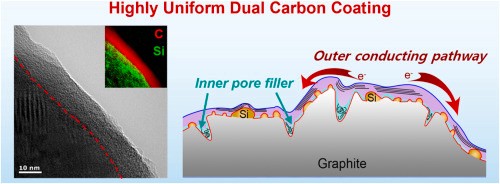
연구
Research Outcome
미래를 창조하는 포스텍 화학공학과
Finely regulating the surface pore structure towards long-lasting stability of practical Si composite anode
- Title of paper
- Finely regulating the surface pore structure towards long-lasting stability of practical Si composite anode
- Author
- [김원배 교수님 연구실] 리튬이온 이차전지용 차세대 실리콘 음극재의 장수명 안정성 위한 표면 기공 구조 조절 연구
- Publication in journal
- J. Power Sources 2025, 644, 237146
- Publication date
- 20250715

[Abstract]
This study introduces a dual carbon coating strategy that finely regulates the pore structure on silicon/graphite anodes to significantly enhance initial coulombic efficiency (ICE), specific capacity, and cycling stability in lithium-ion batteries. The process begins with a coal tar coating which reduces the surface area by sealing small mesopores but initially worsens the ICE due to the uneven morphology of amorphous carbon. To restore uniformity, acetylene chemical vapor deposition is introduced as a "healing agent" at the end of carbonization step. This synergistic dual coating, combining liquid coal tar with gaseous acetylene, not only fine-tunes the pore sizes but produces highly uniform carbon layers that robustly encapsulate Si surface. Superior to individual coatings of coal tar or acetylene alone, the dual coating improves ICE, and also capacity retention while doubling conductivity compared to bare Silicon/graphite. Electrochemical evaluations of the optimized dual-coated Silicon/graphite demonstrate an ICE of 88.3 % even at a commercial mass loading of 7 mg cm−2 in half-cell configurations and a specific capacity of 60 mAh g−1 after 450 cycles at C/3 rate in full cell tests. This simple and scalable surface engineering coupled with the use of cost-effective precursors is suitable for large-scale production of high-energy-density Si-based anodes.



